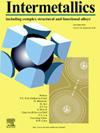Development and characterization of CoCrFeNi high entropy alloy composites reinforced by B4C ceramic particles
IF 4.3
2区 材料科学
Q2 CHEMISTRY, PHYSICAL
引用次数: 0
Abstract
To address the challenge of the low yield strength of single-phase FCC high-entropy alloys (HEAs), developing high-performance HEA composites has emerged as a promising strategy for enhancing the mechanical properties of HEAs. In this study, we propose a novel CoCrFeNi-based HEA composites incorporating a small amount of B4C ceramic particles. The influence of varying B4C ceramic particle content on the microstructure evolution and mechanical properties of CoCrFeNi(B4C)x HEAs was systematically investigated. Microstructure analysis reveals that increasing the B4C ceramic particles promoted the precipitation of M7C3 carbides at grain boundaries, resulting in a dendritic microstructure. Mechanical testing demonstrated a significant improvement in yield strength and Vickers hardness, attributed to the synergistic strengthening of solution and precipitation strengthening. Furthermore, the microhardness of the M7C3 carbides increased from 12.1 GPa to 15.5 GPa with higher B4C ceramic particle content, highlighting the contribution of these carbides to the overall hardness of the composite. This design strategy exploits the synergy between the metal matrix and ceramic reinforcements, improving mechanical performance and offering new possibilities for the development of advanced materials for demanding industrial applications.
B4C陶瓷颗粒增强CoCrFeNi高熵合金复合材料的研制与表征
为了解决单相FCC高熵合金(HEAs)屈服强度低的难题,开发高性能的HEA复合材料已成为提高HEAs力学性能的一种有前景的策略。在这项研究中,我们提出了一种含有少量B4C陶瓷颗粒的新型cocrfeni基HEA复合材料。系统研究了不同B4C陶瓷颗粒含量对CoCrFeNi(B4C)x HEAs显微组织演变和力学性能的影响。显微组织分析表明,增加B4C颗粒可促进晶界处M7C3碳化物的析出,形成枝晶组织。力学试验表明,由于溶液和析出强化的协同强化,屈服强度和维氏硬度有了显著提高。此外,随着B4C陶瓷颗粒含量的增加,M7C3碳化物的显微硬度从12.1 GPa提高到15.5 GPa,凸显了这些碳化物对复合材料整体硬度的贡献。这种设计策略利用了金属基体和陶瓷增强剂之间的协同作用,提高了机械性能,并为开发要求苛刻的工业应用的先进材料提供了新的可能性。
本文章由计算机程序翻译,如有差异,请以英文原文为准。
求助全文
约1分钟内获得全文
求助全文
来源期刊

Intermetallics
工程技术-材料科学:综合
CiteScore
7.80
自引率
9.10%
发文量
291
审稿时长
37 days
期刊介绍:
This journal is a platform for publishing innovative research and overviews for advancing our understanding of the structure, property, and functionality of complex metallic alloys, including intermetallics, metallic glasses, and high entropy alloys.
The journal reports the science and engineering of metallic materials in the following aspects:
Theories and experiments which address the relationship between property and structure in all length scales.
Physical modeling and numerical simulations which provide a comprehensive understanding of experimental observations.
Stimulated methodologies to characterize the structure and chemistry of materials that correlate the properties.
Technological applications resulting from the understanding of property-structure relationship in materials.
Novel and cutting-edge results warranting rapid communication.
The journal also publishes special issues on selected topics and overviews by invitation only.
 求助内容:
求助内容: 应助结果提醒方式:
应助结果提醒方式:


